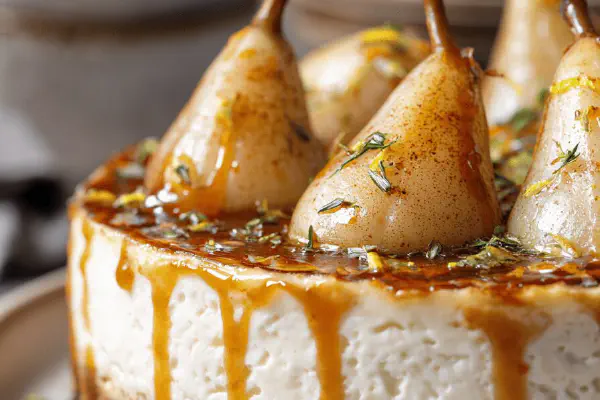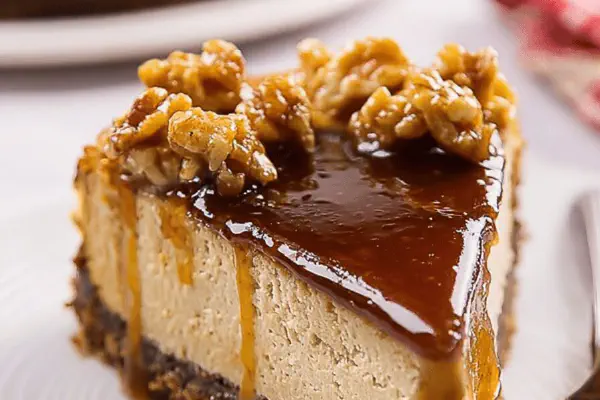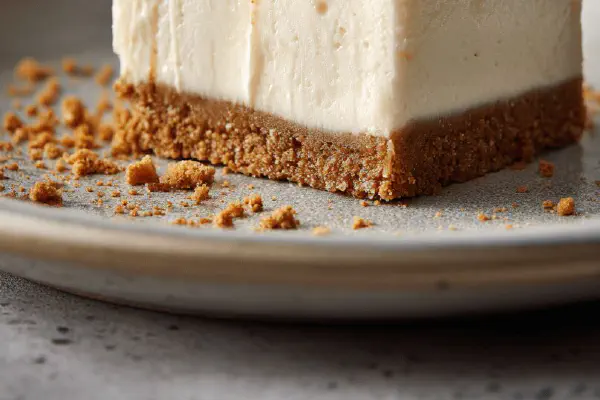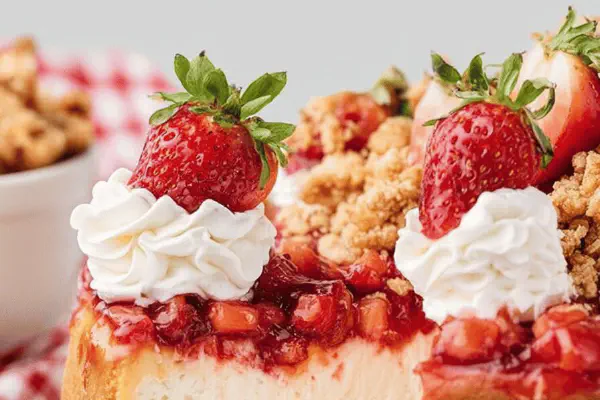Maple Pear Cheesecake

By Emma
Certified Culinary Professional
Ingredients
- == Crust ==
- 180 g (6 oz) graham crackers or digestive biscuits, finely ground
- 85 g (6 tbsp) unsalted butter, browned and cooled
- 20 ml (1 tbsp) maple sugar or brown sugar
- 1 ml (¼ tsp) fine sea salt
- == Cheese filling ==
- 2 packages of 250 g each cream cheese, softened
- 120 ml (½ cup) sour cream full fat
- 100 ml (about ½ cup) pure maple syrup
- 25 ml (2 tbsp) all-purpose flour
- 2 eggs
- zest of 1 small lemon
- == Roasted pears ==
- 2 firm Bartlett pears, thinly sliced 3 mm (1/8 in) on mandoline
- 50 ml (3 tbsp) maple syrup
- ½ tsp ground cinnamon
- ¼ tsp freshly grated nutmeg
About the ingredients
Method
- == Crust ==
- Oven rack in middle. Heat oven to 175 C (350 F). Grease 20 cm (8 in) springform pan. Line base with parchment paper.
- Process graham crackers to fine crumbs — uniform texture matters. Toss crumbs with browned butter (aroma shifts, richer flavor), maple sugar, and salt in bowl. Press firmly bottom and up sides, about three-quarters height. Look for even thickness and no loose areas.
- Bake crust 10 minutes until edges crisp and golden but not burnt. Let cool slightly, firm to touch but warm.
- Wrap outside pan tightly with double layer heavy duty foil extending above pan lip. Prevents water bath leaks later. Reduce oven to 160 C (320 F).
- == Cheese filling ==
- In clean food processor or stand mixer, beat cream cheese until fluffy. Add sour cream and maple syrup; keep mixing till just smooth—don't overbeat or risk air bubbles.
- Add flour and lemon zest, then one egg at a time, blending gently after each. Scrape sides. Stop as soon as mixture looks uniform; slight lumps indicate no overmixing.
- Pour filling over crust. Tap pan lightly on counter to release trapped air. Perfectly smooth surface reduces cracks.
- == Baking ==
- Set pan in deeper roasting dish. Pour hot water around pan until it reaches one-third up side—hot water steams, stabilizes baking temperature. This technique crucial for crack-free, creamy center.
- Bake approx. 55 minutes. After 50 minutes, check center with instant thermometer—target 62 to 64 C (143–147 F). Cake edges should be set, center slightly jiggle. Don't overcook or it’ll crack and dry.
- Shut oven off, leave cake inside with door ajar for 10 minutes to prevent sudden temperature drop.
- Remove pan from water bath carefully. Peel off foil layers. Let cool on rack for 1 hour. Cool completely in fridge 4 hours minimum or overnight is better. Do not rush cooling; rapid cooling causes cracks.
- == Roasted pears ==
- Raise oven temp to 190 C (375 F). Line baking sheet with silicone mat or parchment.
- Mix maple syrup with cinnamon and nutmeg. Arrange pear slices in single layer. Brush half maple glaze over pears.
- Roast pears 10 minutes until edges turn golden and syrup thickens slightly, caramel aroma develops.
- Flip slices, brush remaining glaze, roast another 8-10 minutes until soft but not mushy. Pears should yield gently to finger pressure but hold shape.
- Let cool at room temp 20-30 minutes. Stored pears can be refrigerated up to 2 days if needed.
- == Assembly ==
- Run thin paring knife around pan edges to loosen cheesecake gently. Remove springform sides.
- Slide parchment paper gently under cake base if it sticks, transfer to serving plate.
- Top cheesecake evenly with roasted pears, overlapping slightly. Pear juices may glaze cake edges subtly.
- Store under dome in fridge. Lasts 3-4 days. Freeze after cheesecake step with plastic wrap and foil, thaw overnight in fridge before adding pears.
Cooking tips
Chef's notes
- 💡 Press crumb crust firmly but not oily. Use bottom of glass for pressure. Brown butter needs to be cool or crumbs melt prematurely changing texture. Watch crumbs closely before mixing, some bits too big weaken crust.
- 💡 Don’t overbeat filling. Mix cream cheese fluffy, then add sour cream and syrup gently. Eggs one at a time. Scrape sides often. Slight lumps better than bubbly mix that cracks later. Use lemon zest for brightness, skip and filling dulls.
- 💡 Wrap pan tightly in double foil extending above rim. Keeps water bath leaks at bay. Water bath temp must be hot but not boiling or crust soggy edge. Check water level midway and top with hot water silently if low.
- 💡 Roast pears thin and even – 3 mm or 1/8 inch. Brush syrup mix hands-free, too thick glaze burns. Flip once mid-roast. Pears soft but not mushy, edges golden not black. Let cool room temp before topping cake to avoid shock.
- 💡 Cool cheesecake slow and steady. After baking turn oven off, ajar door 10 min. Remove from bath carefully, peel foil, cool 1 hour on rack, then chill minimum 4 hours fully cold or overnight. Rushing cool causes cracks.
Common questions
Can I use salted butter for crust?
Yes but cut salt in recipe. Salt adds flavor but too much kills crust balance. Adjust to taste or use unsalted if possible. Butter saltiness varies brands so test crumb flavor before pressing.
How to avoid cracks in filling?
Don’t overbeat eggs or mix too long. Slight lumps better than air bubbles. Water bath warms cake evenly, prevents edges cooking faster than center. Remove pan from bath carefully to keep crust firm.
What if no maple sugar available?
Use light or dark brown sugar as substitute. Coconut sugar works but less sweet so balance with syrup. Maple sugar caramelizes better, gives deeper flavor. Adjust quantities to taste and texture feeling.
How long does cheesecake keep?
Keeps refrigerated 4 days tightly covered. Freeze after bake, before pears step, wrapped well. Thaw fully in fridge overnight, then add roasted pears to maintain texture. Pears refrigerated max 2 days separately.



